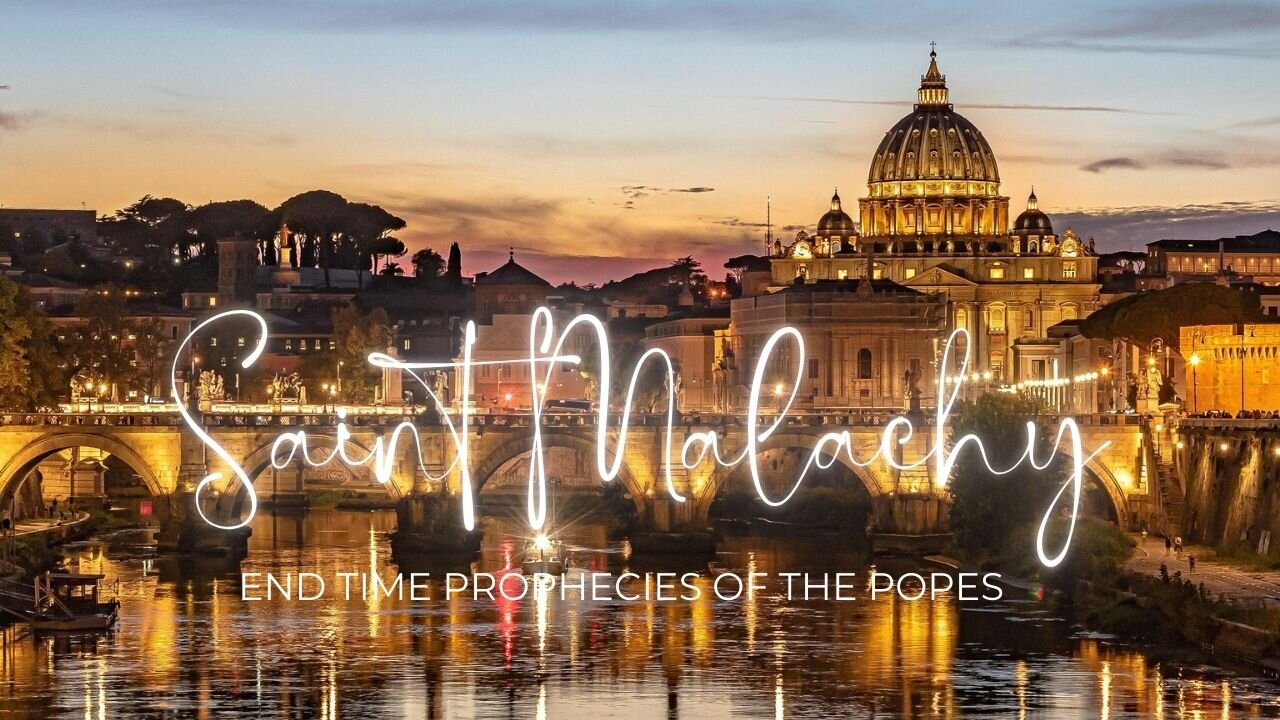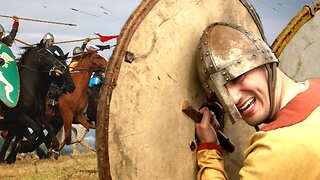Premium Only Content

Saint Malachy's 'Prophecies of The Popes' | End Time Prophecy of Pope Francis
The prophecy of St. Malachy is actually a set of prophecies written by an Irish priest. St. Malachy, whose given name was Mael Maedoc, lived from AD 1094 to AD 1148, and he was the first Irish man to be canonized by the Roman Catholic Church. His prophecy concerns a line of Popes, beginning with Pope Celestine III and ending with the current Popes. It is a list of 113 Popes, each one bearing a prophetic title that supposedly corresponds symbolically to the actual man in office.
The prophecy goes on to say of the supposed final pope: “In the final persecution of the Holy Roman Church, there will sit Peter the Roman, who will pasture his sheep in many tribulations, and when these things are finished, the city of seven hills will be destroyed, and the dreadful judge will judge his people. The End.”
According to an account put forward in 1871 by Abbé Cucherat, Malachy was summoned to Rome in 1139 by Pope Innocent II to receive two wool palliums for the metropolitan sees of Armagh and Cashel. While in Rome, Malachy purportedly experienced a vision of future popes, which he recorded as a sequence of cryptic phrases. This manuscript was then allegedly deposited in the Vatican Secret Archives, and forgotten about until its rediscovery in 1590, just in time for a papal conclave occurring at the time.
The interpretation of the entries for pre-publication popes provided by Wion involves close correspondences between the mottos and the popes' birthplaces, family names, personal arms, and pre-papal titles. For example, the first motto, Ex castro Tiberis (from a castle on the Tiber), fits Celestine II's birthplace in Città di Castello, on the Tiber.
In recent times, some interpreters of prophetic literature have drawn attention to the prophecy due to its imminent conclusion; if the list of descriptions is matched on a one-to-one basis to the list of historic popes since publication, Benedict XVI (2005–13) would correspond to the second to last of the papal descriptions, Gloria olivae (the glory of the olive). The longest and final verse predicts the Apocalypse.
"In the final persecution of the Holy Roman Church, there will sit [i.e., as bishop]. Peter the Roman, who will pasture his sheep in many tribulations, and when these things are finished, the city of seven hills [i.e. Rome] will be destroyed, and the dreadful judge will judge his people. The End.
Several historians and interpreters note the prophecy leaves open the possibility of unlisted popes between "the glory of the olive" and the final pope, "Peter the Roman". In the Lignum Vitae, the line In persecutione extrema S.R.E. sedebit forms a separate sentence and paragraph of its own. While often read as part of the "Peter the Roman" entry, other interpreters view it as a separate, incomplete sentence explicitly referring to one or more popes between "the glory of the olive" and "Peter the Roman".
-
 16:25
16:25
The Aquarius Bus
3 months agoSalt Lake City, Utah. 1860. Built or Found? Again, where are the people?
1.33K6 -
 LIVE
LIVE
Sarah Westall
2 hours agoDOGE: Crime & Hysteria bringing the Critics & the Fearful - Plus new CDC/Ukraine Crime w/ Dr Fleming
525 watching -
 45:39
45:39
Survive History
8 hours ago $0.07 earnedCould You Survive in the Shield Wall at the Battle of Hastings?
1.53K1 -
 1:50:28
1:50:28
TheDozenPodcast
7 hours agoViolence, Abuse, Jail, Reform: Michael Maisey
2.24K -
 23:01
23:01
Mrgunsngear
1 day ago $1.70 earnedWolfpack Armory AW15 MK5 AR-15 Review 🇺🇸
11.4K12 -
 25:59
25:59
TampaAerialMedia
1 day ago $0.17 earnedUpdate ANNA MARIA ISLAND 2025
3.41K1 -
 59:31
59:31
Squaring The Circle, A Randall Carlson Podcast
9 hours ago#039: How Politics & War, Art & Science Shape Our World; A Cultural Commentary From Randall Carlson
3.39K2 -
 13:21
13:21
Misha Petrov
9 hours agoThe CRINGIEST Thing I Have Ever Seen…
3.56K29 -
 11:45
11:45
BIG NEM
5 hours agoWe Blind Taste Tested the Best Jollof in Toronto 🇳🇬🇬🇭
1.15K -
 15:40
15:40
Fit'n Fire
8 hours ago $0.04 earnedArsenal SLR106f & LiteRaider AK Handguard from 1791 Industries
1.01K1